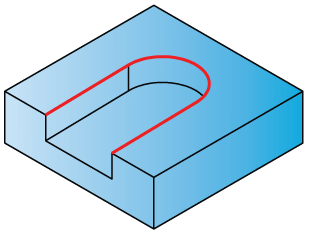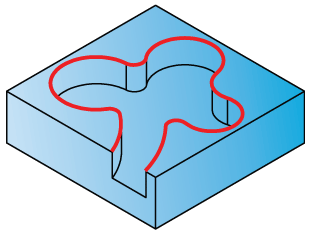Spine slot
This ToolBox Cycles strategy enables you to perform the machining of a slot opened from one side. SolidCAM automatically determines the spine of the slot and performs the machining according to the spine’s shape. In this sub-operation, the tool approaches the material along the spine and then machines the walls of the slot.
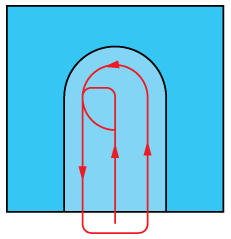
Geometry definition
The strategy provided by this sub-operation can be performed only on open chains; accordingly, the geometry should contain at least one open chain. The geometry containing only closed chains is considered as unsuitable. The geometry containing a number of open chains is considered as suitable. The mixed geometry containing a number of open and closed chains is considered as suitable, but all the closed chains are ignored during the tool path calculation.
This sub-operation is intended to perform open slot machining. The open slot shape should be selected as shown below.
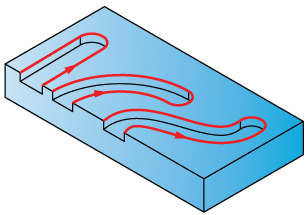
|
The ideal slot shape intended to be machined with this sub-operation consists of two equidistant walls connected with an arc.
The example below illustrates the shape that is not intended to be machined with this sub-operation, therefore choosing such geometry can cause errors during tool path calculation.
|
The direction of the chosen geometry should be defined in such way to enable the tool to perform the climb milling inside the slot geometry.
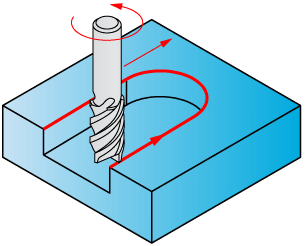
Technological parameters
Step down
SolidCAM enables you to perform the slot machining in a number of cutting passes distributed along the tool axis. The distance between two successive cutting levels is defined by the Step down parameter. The Equal step down option enables you to define a number of evenly distributed cutting levels. SolidCAM automatically calculates the actual step down to keep an equal distance between all passes, while taking into account the specified Max. Step down value so that it is not exceeded.
Spine tolerance
During the tool path calculation, SolidCAM automatically determines the spine of the defined geometry shape. The Tolerance parameter enables you to define the precision of the spine determination.
Extension
During the machining, the tool path is extended over the slot entrance in order to perform the approach to the cutting area from the outside. The Extension section enables you to define the tool path extension either by percentage of the tool diameter (the % of tool diameter option) or by value (the Value option).
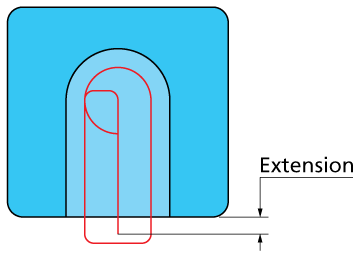
Offsets
This section enables you to define Wall and Floor offsets for this sub-operation. The Wall offset is applied to the walls of the slot; the specified offset is left unmachined during the current sub-operation. The Floor offset is applied to the floor of the slot; the specified offset is left unmachined during the current sub-operation. When the Floor offset value is specified, SolidCAM performs the machining by the Z-levels defined with the Step down parameter. The machining is performed until the Floor offset level.
The Retract Height parameter enables you to define the height above the cutting level where the retract motion is performed.
Tool path calculation
At the first stage of the tool path calculation, SolidCAM determines the spine of the slot. The extension is applied to the spine in order to extend it outside of the material.
The tool starts the machining in the beginning of the spine extension, penetrates the material and continues to machine the slot along the spine.
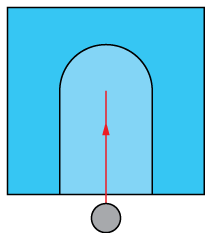
When the center point of the arc is reached, the tool moves to the left wall of the slot, maintaining the climb milling. Then the tool machines the left wall and leaves the material up to the extension distance.
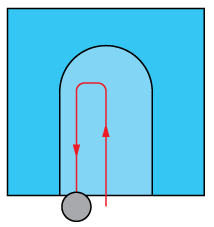
Then the tool moves to the right wall of the slot and machines it in the climb direction.
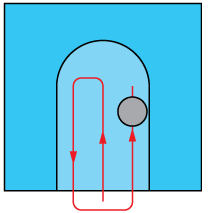
When the wall is machined, the tool continues the machining of the arc and retreats from the material in continuation of the arc.
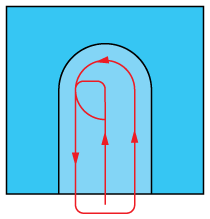
|
Note that all the sharp corners in the tool path are rounded. |
